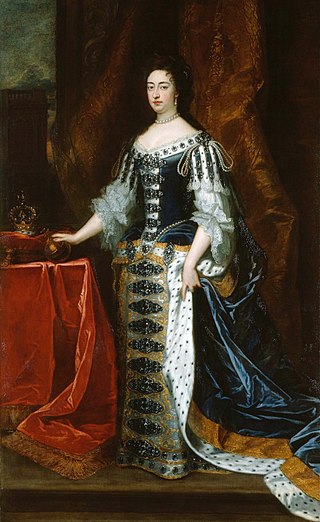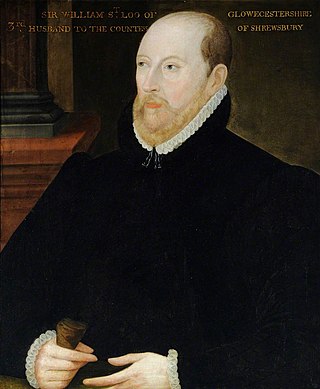Related Research Articles

Elizabeth I was Queen of England and Ireland from 17 November 1558 until her death in 1603. She was the last monarch of the House of Tudor.

Mary II was Queen of England, Scotland, and Ireland, co-reigning with her husband, King William III and II, from 1689 until her death in 1694. She was also Princess of Orange following her marriage on 4 November 1677. Her joint reign with William over Britain is known as that of William and Mary.

1694 (MDCXCIV) was a common year starting on Friday of the Gregorian calendar and a common year starting on Monday of the Julian calendar, the 1694th year of the Common Era (CE) and Anno Domini (AD) designations, the 694th year of the 2nd millennium, the 94th year of the 17th century, and the 5th year of the 1690s decade. As of the start of 1694, the Gregorian calendar was 10 days ahead of the Julian calendar, which remained in localized use until 1923.

The monarchy of the United Kingdom, commonly referred to as the British monarchy, is the form of government used by the United Kingdom by which a hereditary monarch reigns as the head of state, with their powers regulated by the British Constitution. The term may also refer to the role of the royal family within the UK's broader political structure. The current monarch is King Charles III, who ascended the throne on 8 September 2022 upon the death of Queen Elizabeth II, his mother.

James Hepburn, 1st Duke of Orkney and 4th Earl of Bothwell, better known simply as Lord Bothwell, was a prominent Scottish nobleman. He was known for his marriage to Mary, Queen of Scots, as her third and final husband. He was accused of the murder of Mary's second husband, Henry Stuart, Lord Darnley, a charge of which he was acquitted. His marriage to Mary was controversial and divided the country; when he fled the growing rebellion to Norway, he was arrested and lived the rest of his life imprisoned in Denmark.
A prince consort is the husband of a monarch who is not a monarch in his own right. In recognition of his status, a prince consort may be given a formal title, such as prince. Most monarchies do not allow the husband of a queen regnant to be titled as a king because it is perceived as a higher title than queen, however, some monarchies use the title of king consort for the role.

Thomas Howard, 4th Duke of Norfolk,, was an English nobleman and politician. He was a second cousin of Queen Elizabeth I and held many high offices during the earlier part of her reign.

Matthew Stewart, 4th Earl of Lennox was a leader of the Catholic nobility in Scotland. He was the paternal grandfather of King James VI of Scotland. He owned Temple Newsam in Yorkshire, England.
Events from the year 1819 in the United Kingdom.
Events from the year 1808 in the United Kingdom.
Events from the year 1823 in the United Kingdom.
Events from the year 1660 in England. This is the year of the Stuart Restoration.
Events from the year 1689 in England.
Events from the 1530s in England.
The Treaty of Greenwich contained two agreements both signed on 1 July 1543 in Greenwich between representatives of England and Scotland. The accord, overall, entailed a plan developed by Henry VIII of England to unite both kingdoms. The first sub-treaty helped to establish peace between the Kingdom of England and the Kingdom of Scotland. The second sub-treaty was a marriage proposal between Edward VI of England and Mary, Queen of Scots. In this part of the treaty, it was agreed that Mary would be accompanied by an English nobleman/gentleman until she was ten years old. Afterwards, Mary would reside in England until the time of her marriage. Also, the Treaty of Greenwich permitted the Kingdom of Scotland to maintain its laws. Even though the Earl of Arran signed the accord on 1 July and ratified it on 25 August 1543, the Treaty of Greenwich was ultimately rejected by the Parliament of Scotland on 11 December 1543, leading to eight years of Anglo-Scottish conflict known as the Rough Wooing.
Events from the 1510s in England.
Events from the 1550s in England. This decade marks the beginning of the Elizabethan era.
Events from the 1560s in England.
Events from the 1690s in the Kingdom of Scotland.
References
- 1 2 3 Williams, Hywel (2005). Cassell's Chronology of World History . London: Weidenfeld & Nicolson. ISBN 0-304-35730-8.
- ↑ Penguin Pocket On This Day. Penguin Reference Library. 2006. ISBN 0-14-102715-0.
- ↑ "Greenwich Hospital" . Retrieved 2012-03-07.
- ↑ "Lottery Office records". The National Archives. Retrieved 2023-10-18.
- ↑ "Mary II | Biography & Accomplishments | Britannica". www.britannica.com. Retrieved 4 May 2022.